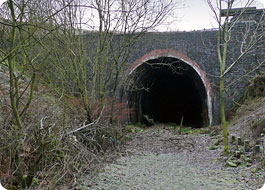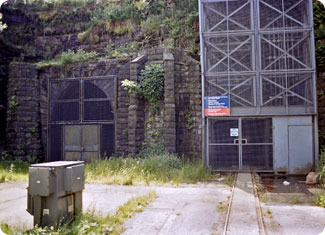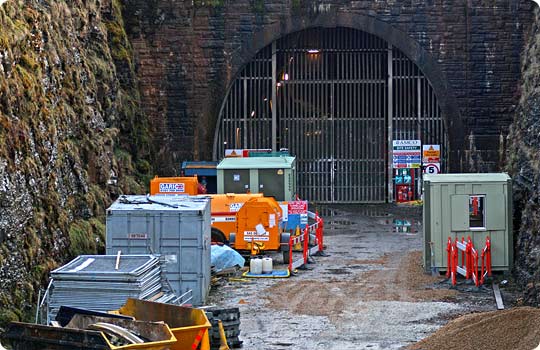Clouds descend over Woodhead

- Author: Graeme Bickerdike
- Source: The Rail Engineer
- Published: January 2009
Clouds descend over Woodhead
Any parent who’s ever been badgered to bestow upon their offspring the latest electronic i-Gimmick will be familiar with the phrase “we’ll see” – a dressed-up version of the word ‘no’, buying a few days peace by apparently leaving the door ajar. It’s basically ‘spin’, spawned by the same culture which causes government to launch feasibility studies when their conclusions have already been reached.
The future of Woodhead Tunnel descended into this thick cloud before Christmas with the publication of two documents – Network Rail’s consultation version for its Yorkshire & Humber Route Utilisation Strategy, and a report by The Northern Way on the tunnel’s potential for future rail use. Neither locks the door and throws the key away but only a delusionist would describe it as wide open.
The 112-page draft RUS touches on Woodhead in six paragraphs dealing with long-term challenges – Control Period 6 (CP6) and beyond. This level of analysis adds some weight to the arguments of those who accuse both the industry and government of short-termism. Someone needs to be looking further and deeper into the future. With the North’s creaking transport infrastructure forecast to witness a huge rise in freight traffic over the next 20 years, it’s fair to assert that expansion of our trans-Pennine rail network should be receiving vigorous attention now, planning timescales being what they are. Environmental obligations reinforce this view.

Photo: Paul Richman
In acknowledging the government’s aspiration of doubling traffic levels over the next three decades, the draft RUS recognises that trans-Pennine growth consistently out-performs the national average. That means that the main route via Diggle could have reached capacity before CP6, even with the sticking plaster of longer trains being introduced. Though, on the face of it, this offers hope for Woodhead’s revival, Network Rail’s sights seem to be set elsewhere – in fact, across the River Tame from the existing line.
East of the hills, the Diggle route’s formation formerly hosted four tracks – reinstating these would be relatively straight forward, although linespeeds could be compromised as the existing two tracks make best use of the available land. The Nicholson and Nelson single bore tunnels at Standedge would have to be renovated and brought back into use.
Things prove trickier to the west, through the Tame Valley. Here, the document points to the former Micklehurst loop as an unlikely way forward. Since closure in 1966, this ‘relief line’ into Stalybridge has lost many of its structures including a 16-arch viaduct, whilst two of its three tunnels are partly buried. Residential development now occupies sections of trackbed. Cue the feasibility study?


The old Matlock-Buxton route through the Peak District – which Railtrack once hoped to reopen – is put forward positively as a constraint-busting alternative to the Hope Valley line, shouldering much of the burden from eastbound aggregates traffic.
Though Woodhead merits more detail – presumably to calm its vocal advocates – the tone is generally downbeat. “There are several significant practical limitations” it states, most notably the reversing requirement at Sheffield’s Woodburn Junction and the impact of Woodhead traffic on the network around Manchester. It would “do little to relieve the key capacity shortage between Leeds and Manchester. The main benefits…would arise from dealing with congestion on the cross-Pennine road network rather than solving rail network issues.”
For the ‘Save the Woodhead Tunnel’ campaign group, this latter point holds no water. Rail must shoulder “some of the burden which is currently placed on our motorways” it states in its consultation response. “The priority must be to identify a robust trans-Pennine freight corridor rather than the vague possibility of enhancements to the Diggle route where [TransPennine Express] conflicts will continue to cause headaches”. This assertion is based on a study by The Northern Way – a collaboration of the north’s three regional development agencies – which forecasts a massive potential rise in container flows by 2030, if unrestrained by capacity and structure gauge.
The Northern Way itself has not been silent on Woodhead with a report considering the tunnel’s possible re-use for rail. Published at the end of October, it neatly sidestepped any comment on the merits of reopening the railway, focussing partly on dispelling myths about the National Grid’s ongoing project to transfer electricity cables from Woodhead’s Victorian north tunnel into British Rail’s 1954 bore.

Photo: John Ashton
It does however note that if the North’s productivity growth is to be maximised, strategic ‘gaps’ need to be closed, including the absence of a trans-Pennine rail plan – a view driven by the same study on container traffic which has so animated the tunnel’s campaign group.
“The Manchester Hub is the most significant rail bottleneck in the North” according to the report, and the Northern Way is working with Network Rail, the DfT and Manchester City Region on enhancement options. These efforts are likely to increase pressures on trans-Pennine capacity in the longer term.
As far as Woodhead is concerned, The Northern Way sees it as just one of many alternatives. It too questions its likely impact on the existing Hadfield-Manchester corridor as well as the network to the east of Penistone. Before preferred options can be identified, there needs to be “greater clarity about the objectives…and how well each [option] goes to meeting those objectives”.
So who is defining them? Where do the priorities lie – a dedicated freight route, high speed rail, more regional passenger services, all of the above? No-one seems willing to break the silence. The nature of the challenge will demand a suite of solutions, not a single one – rebuilding Woodhead would, in itself, cause more problems than it solves. But it needs to remain on the table.

Photo: Four by Three
The route’s future viability depends in part on the potential for relocating the National Grid’s cables back into the Victorian tunnels – currently in poor condition – if the railway needs to reclaim the BR bore. As things stand, NG’s intention is to seal and abandon them after they’ve moved out. So far, campaigners have drawn only woolly Ministerial mutterings on a maintenance regime beyond 2011. A major collapse thereafter could, in cost and engineering terms, colour any judgment on reopening the route.
In conclusion, The Northern Way serves up more unpalatable food for thought. Any possible re-use of the ’54 tunnel “would have to meet modern standards. That it once carried rail traffic is not material.” Don’t underestimate the implications of this. It claims that an evacuation walkway would have to be provided as well as a barrier between the tracks as protection against a derailment. A modern electrification system would necessitate greater clearances than those currently available. In fact the tunnel “would be preferably built as a twin bore”!
Perhaps it would be easier just to say ‘no’ now.





